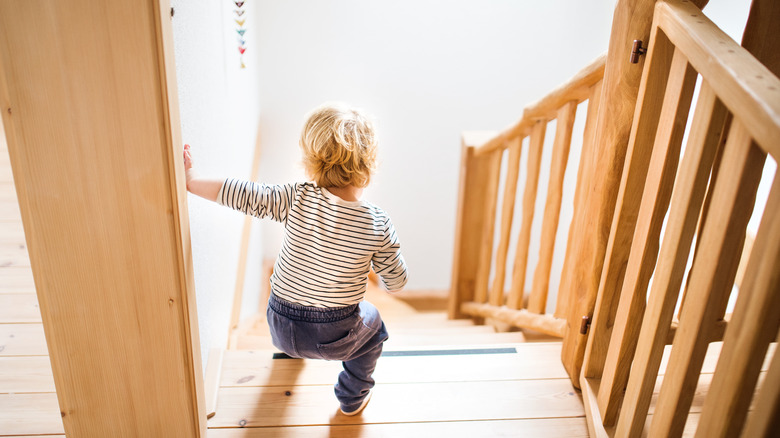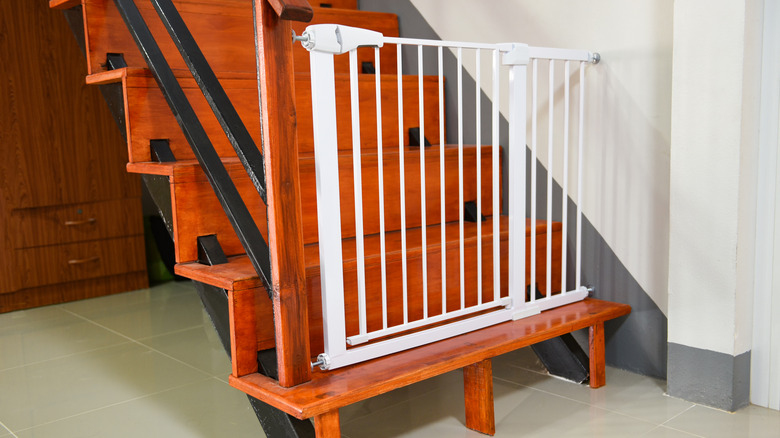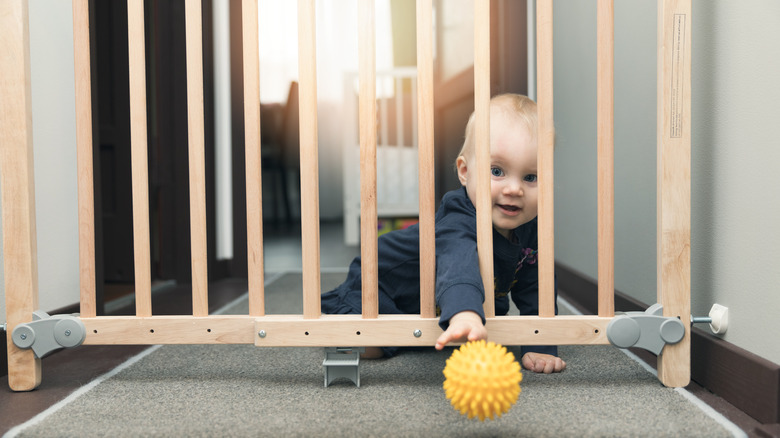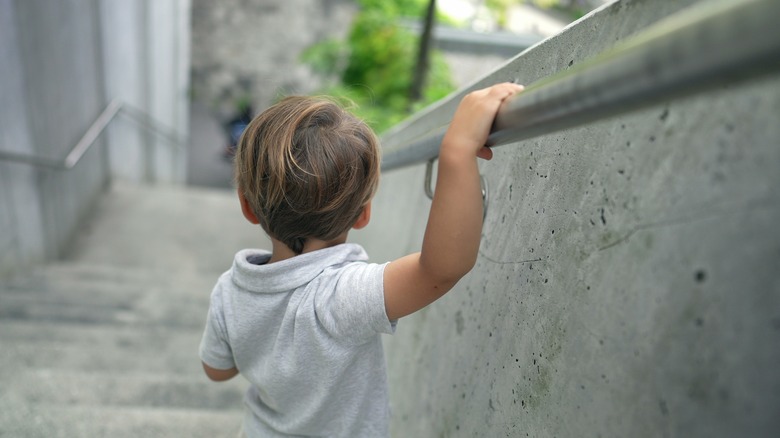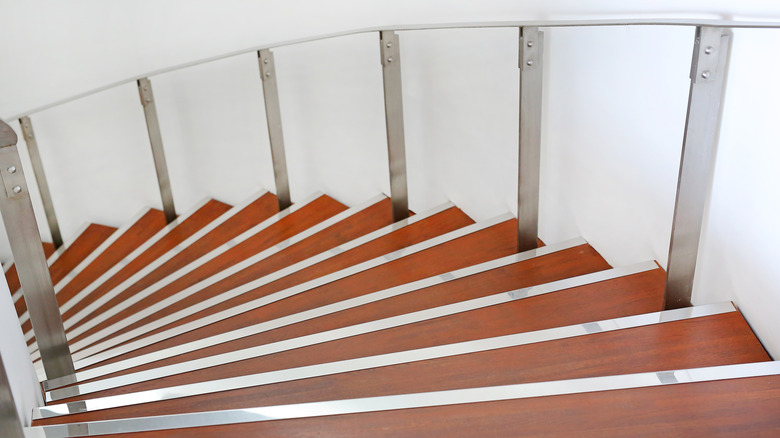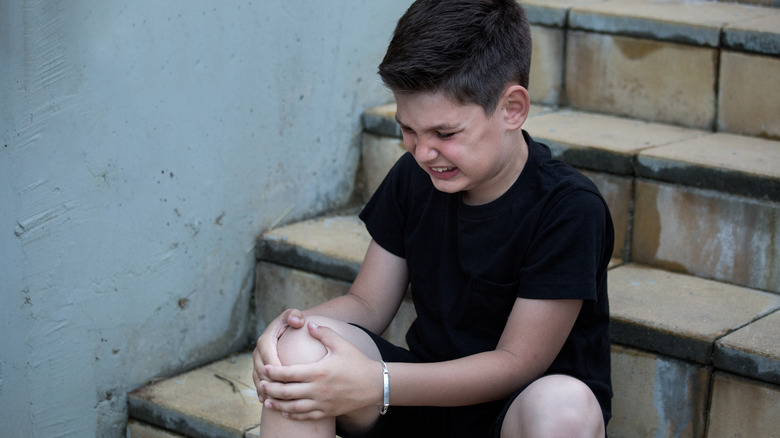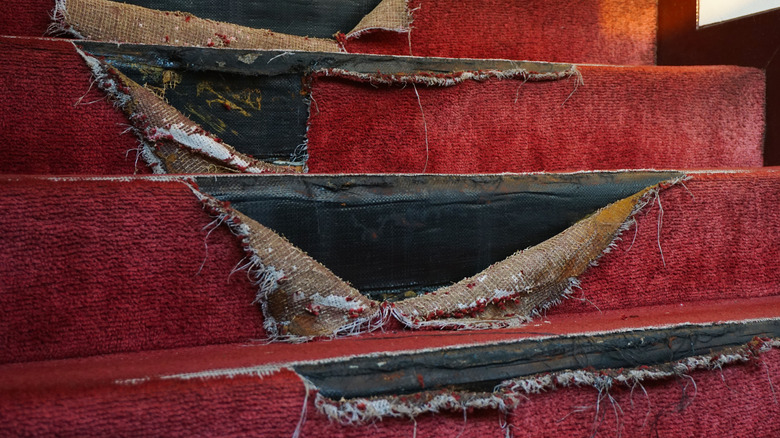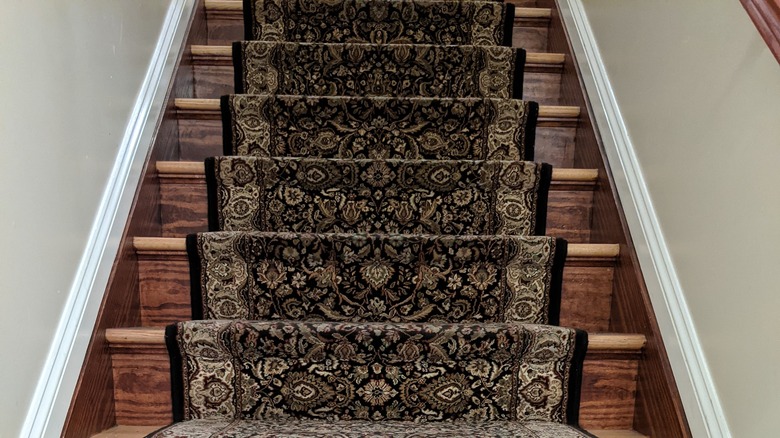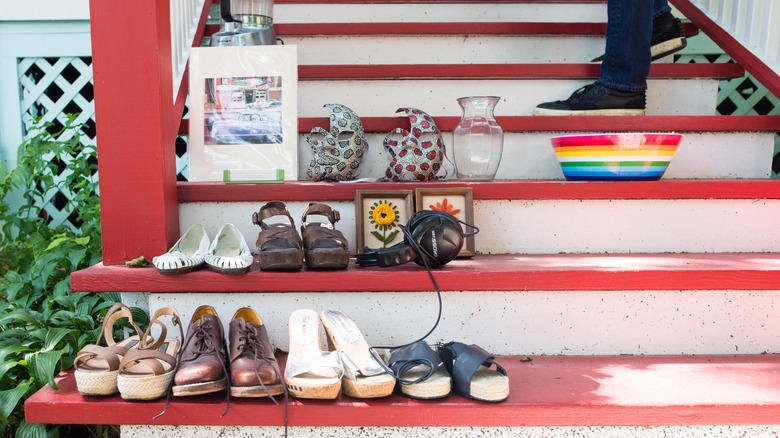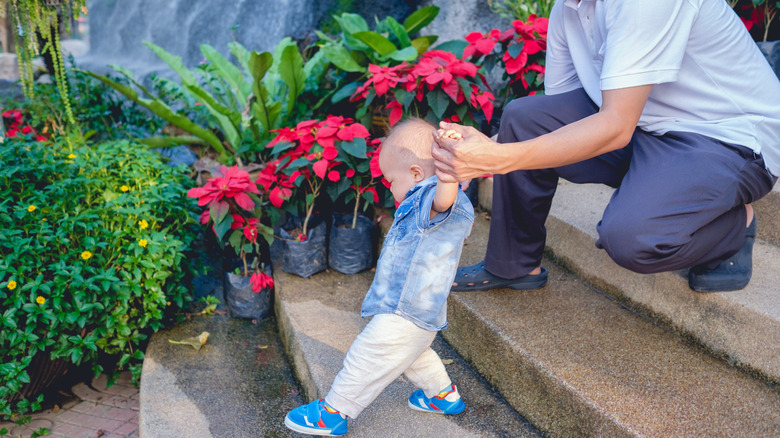Tips On How To Make Your Stairs Child-Proof
We may receive a commission on purchases made from links.
Childproofing is evidence of our devotion to our children. We understand from common sense, experience, and tradition that stairs hold immense catastrophe potential for little ones. Stairs are usually not so ominous if they are in good repair. However, the Stairbuilders and Manufacturers Association says that stairs in poor condition or with incorrect use are the real danger for children. How much danger? There's typically over 1 million injuries per year (via the CDC). Despite this, in 2006, only eight of the 1,808 deaths were children under the age of 15. Compare this with 842 deaths between the ages of 78 and 89, and it seems clear that people watch their kids near stairs. However, is it a good enough job? Children under age five experience 46.5 injuries per 10,000 population, about three times the childhood cancer rate (via the National Library of Medicine) and slightly less than the odds of being injured in a motor vehicle accident (via WISQARS).
Of course, the danger your household stairs present depends on several factors and how you baby-proof your home. A 2004 report called "State of Home Safety in America" surveyed 1,000 households and found that 56 percent of households have at least one set of stairs with four or more steps, and of those, a third didn't have banisters or handrails on at least one of those sets (via ICC). About 43 percent of households with children six or younger had stairs without banisters or handrails. With that in mind, here are some tips to make your stairs safe and child-proof.
Follow stair building codes
Building codes play a significant role in reducing the number of injuries from falling on stairs. For example, the code states that stair riser height shouldn't vary by more than ⅜ of an inch. A mere ½-inch difference can result in tripping and falls, according to Weekend Builds. It's essential to keep your home up to code. If you live in an older house, modify the stairs to be current or take other action to make up for any shortcomings in the older construction.
Since the language of building codes can be a bit impenetrable, there is no shortage of primers and explainers online (via How to Look at a House). The Stairbuilders and Manufacturers Association publishes visual interpretations of building codes related to stairs and other resources for builders, including free downloads of older applicable building codes and visual guides. This Old House has one of the best overviews of IRC code, but it lacks helpful illustrations. A comprehensive home stairway inspection checklist is available online (via the International Association of Certified Home Inspectors).
Of course, building codes are just a baseline for construction that reduces hazards, not the final word in safety. If you're building or remodeling a home, you can certainly exceed the safety standards dictated by the code. For example, research has shown that having a landing partway up your stairs substantially reduces the likelihood of injury from a fall (via Archives of Disease in Childhood). Handrails should go on both sides of a staircase, even though the code only requires one (via Prudent Reviews). As always, check your local codes thoroughly since they might vary from the IRC standards.
Close that baby gate
Using baby gates at the top and bottom of stairs is the number one way parents childproof their stairs, and it's an effective one. Archives of Disease in Childhood found that 45 percent of injuries can be prevented by parents having stair gates and keeping them closed. Other studies have also found clear links between stair gate use and safety (via Oxford Academic). The primary factors for safe baby gate use are consistency and proper installation. They won't help if they're left open or fall down.
There are a handful of different baby gate styles for various purposes. Blueprint Joinery has a useful chart that includes foldable and roller gates for unusual stair configurations where no skirting board is present, pressure gates for doorways, and wall-mounted gates for the top and bottom of most staircases. Follow manufacturer directions to ensure your gate anchors properly. However, the manufacturer doesn't know your particular circumstances or the arrangement of your stairs, so select a stair gate based on where you'll be installing it in the home.
There are a number of helpful tips for getting the most out of your stair gate. Consider installing a doorway gate at the entry to your child's room to eliminate stairway access altogether. Use hardware-mounted gates whenever possible, as pressure gates are less solid and secure. Take care with accordion-style gates, which can trap your child's head, and walkers, which are risky when used at the top of stairs (via Nemours Children's Health).
Use plenty of handrails
Installing handrails properly according to code prevents countless falls and minimizes injuries from falls that happen anyway. The IRC prescribes many dimensions of handrail design and installation. Even the allowable shapes of handrails are described by code, per InspectAPedia. Some code requirements are challenging to achieve in older homes. For example, the requirement that the handrail remains continuous (except where interrupted by a newell or terminated by a handful of flourishes) is sensible. However, it might be hard to achieve without substantial expense, depending on the design of your stairway and surrounding space (via the City of Albany, Georgia).
As stringent as stair building codes are, they offer the best safety for the largest number of people. In the case of stairs, they help reduce falls among the elderly. You can take additional steps to reduce your child's chance of falling. Even if code compliance isn't your goal for a rental or older home, you have a few options. If no railing is present, the first order of business is to install one. Consider a second railing, which gives you and your child more options on a busy stairway. An additional, lower rail at a child-friendly height can also help. The more railings, the merrier!
Install a banister guard
Building codes generally recommend no gaps in and around railings that allow for the passage of a 4-inch sphere. This guideline eliminates the possibility of a child falling through the railing or getting stuck inside. While these codes prevent a child from falling through a banister, they don't stop kids from climbing over and falling. Again, older construction doesn't necessarily even follow the 4-inch rule.
You can eliminate these concerns by installing banister guards. They are an affordable way to make stairs safer and a great DIY project. The typical banister guard is a section of netting, perhaps 10 feet long, and costs between $10 and $30. It secures onto the banister to prevent children from climbing on or through the rails. There are also plastic versions. The simplest DIY version of this approach is easy. You can zip-tie plastic poultry netting to a banister, per Baby Gizmo. The basics are simple, so get as creative as you want. You can also build your banister guard from wood (via Maison de Pax). Another option is to extend your railings with supplemental banister walls, such as the safety walls from Child Senior Safety. Their versions are plexiglass panels framed in aluminum and are relatively simple to install. You can probably make something comparable from wood or aluminum channel.
Complete maintenance and repair tips
Stairways in poor condition are more dangerous than they appear, regardless of their safety features. The age of your home obviously impacts the state of your staircase. Loose steps and railings point to the need for an immediate construction project, but there are other considerations, such as the condition of your carpeting or runners.
Assuming you cannot rebuild or renovate your staircase, there are some measures you can take to mitigate the risks without significant construction. The CDC has a guide to stair inspection. While primarily focused on workplace stairs, you can use the advice for your home. Minimize the falling hazard of short flights of stairs by painting them a noticeably different color or installing accent lighting. For stairs with less than 7 feet of vertical clearance (headroom), paint the ceiling or exposed pipes a high-visibility color to make the obstructions stand out. Secure or replace loose treads that can be a tripping hazard. If tread depth is too shallow, keeping the stairs free of clutter and debris is essential. If your stair nosings aren't prominent enough, paint them a contrasting color and securely attach any loose railing. While this can be a DIY project given enough time and diligence, it might be a job best left to professionals. Remove (by sanding, for example) any protrusions or burrs that might snag skin or clothing.
Stair condition problems are more common among people with fewer financial resources. Since parents in those situations are already aware of and agree with the various stair safety measures (via SAGE Journals), the main barrier is gaining access to safety devices and repairs. If necessary, check with friends, family, churches, and local government organizations for assistance in making stairways as safe as possible for children.
Get a grip with carpet
Carpet is a great way to make stairs safer. However, carpeting can also be a tripping hazard, and stairs are the wrong place for doing a lot of tripping. First and foremost, ensure your carpeting is in good condition and properly attached. Because of the exposed angles and traffic, the carpet on stairs tends to wear badly and is prone to wrinkling and pulling loose. The priority is to make the steps safe. If you have to, temporarily staple the carpet down (as close as possible to the angle where the tread and riser meet). Any time you see "staple" during the description of this task, think construction staple gun or, better yet, a pneumatic crown stapler.
A proper repair, short of installing a new carpet, would involve re-stretching the existing carpet over the tack strip. You can do this with a chisel-like stair tucking tool, sometimes called a stair tool. This tool is handy for forcing carpet into corners while working on stairs, per Home Depot. A Hollywood installation in which the carpet wraps tightly around the stair nosings is much easier with what is, confusingly, also called a stair tool. However, you can do the job manually (via Home Stratosphere). Some installers use a knee-kicker to stretch the carpet, and others don't. If you feel the need, you can usually rent them locally.
Consider carpet alternatives
Carpet is a valuable tool for reducing the number and severity of stairway falls by improving traction and cushioning impacts. If you have hardwood steps and you're thinking about using carpeting to make your stairs safer, there are several alternatives to wall-to-wall carpeting. These options include runners, carpet stair treads, and overstep stair treads. Stair runners might be the first thing that comes to mind for alternatives to carpeting stairs. They work well for adding grip and padding and help protect stairs from heavy traffic, per The Farmhouse Life. However, they are problematic because they are prone to becoming unstuck and disorganized in ways that make them a tripping hazard.
Carpet stair treads are basically miniature rugs, one per stair step, made of low-pile commercial carpet with a skid-resistant backing. They come in many colors and patterns, and you can find matching landing rugs in larger sizes. They are available for $77 in sets of 12 or 15, in four sizes on House Home & More. Other manufacturers offer versions called overstep treads that hang over the front of your stair nosings and are priced comparably on Amazon.
Deal with slippery, cluttered, and dark stairs
There are a handful of reasons you might find that your stairs are more slippery than they should be. Perhaps treatments and finishes were applied incorrectly or too long ago, or the stairs aren't clean, per HomelyVille. Fortunately, you have lots of options for correcting the problem, so it should be simple to handle. You can learn how to properly clean each kind of staircase. In addition to the carpet, you can add anti-slip strips or tape or use anti-slip paint (or additives for paint or sealers), floor finish, and even temporary anti-slip sprays to reduce slipperiness (via Weekend Builds).
One way to make a safe staircase dangerous is to clutter it with toys, clothes, and other stuff that should be elsewhere. Often clutter is a byproduct of everyday home life. Think laundered clothes that haven't made their way upstairs yet. This type of clutter is pretty normal, and the important thing is for you to make a couple of rules. For example, always place items to the side, out of the way. The next time you go where the stuff on the steps goes, you take it up or down, with no exceptions (via Home Storage Solutions 101).
Seeing where you are going is a fundamental part of doing anything safely. The safest, most secure, and slip-proof stair won't help if you put your foot somewhere else. This part is where lighting comes in, along with the added benefit of making your staircase look great. There are several different lighting types for safer stairs, including pinlights on or beside stairs, continuous baseboard lighting, rope lights or ribbons underneath stair nosings, below handrails, or on the riser at the front of steps (via Mecc Interiors Inc). One final stair-lighting tip is to remember that you need switches at both the top and bottom of stairs (via How To Look At A House).
Teach your children well
If you're old enough, you might have a specific song running through your head now. No, not the Crosby, Stills, Nash & Young easy-listening classic, but Stacey the Stair Safety Squirrel's "Stair Safety Song." The short song is set (somewhat disturbingly) to the tune of "London Bridge is Falling Down." The Stairbuilders and Manufacturers Association created the song (and the squirrel) to help you teach your children how to walk on stairs safely. Feel free to start singing it to your kid and make walking on stairs a safe and fun activity for every member of your household.
The Stairbuilders and Manufacturers Association's stair safety book also includes instructive coloring exercises, activities, and reading materials for kids. You can print out the booklet and give it to your child to ensure they know the ins and outs of stairs. It will help prevent falls, trips, and other mishaps in your home as they grow up.
Set a positive example for your kids
When we were discussing all the statistics about stair-related injuries and deaths, something jumped out that we haven't seen discussed much in the safety guidance from manufacturing organizations, bloggers, and safety organizations. About a quarter of stairway accidents involving children under the age of one occurred while an adult carried the child, per the American Academy of Pediatrics. Those children were more than three times as likely to require hospitalization as children injured in other ways. This fact is alarming but unsurprising, given that infants are unlikely to walk down stairs unassisted. In one sense, it's great news because it's generally easier to convince adults than infants to do something in a better way.
Getting your house in order is not just about falls while holding kids. In general, adults are the way kids learn safety rules and habits. More adults in the household usually mean fewer injuries from stair falls because the grownups know the rules and are modeling the correct behavior (via Archives of Disease in Childhood). Learn the rules and follow them to set a positive example for your little ones.
